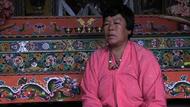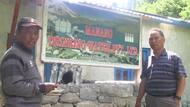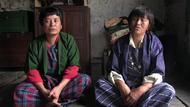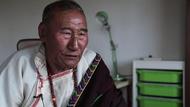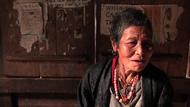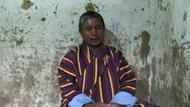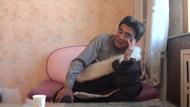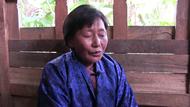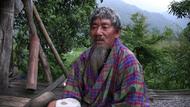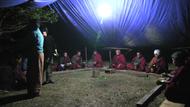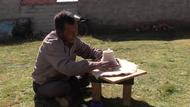Video Overview
Twenty-six year-old monk Dawa Lodrö provides an oral history of Tangpoché Monastery. He explains the monastery’s name and discusses many topics, including the coming of Atisha, his 108 stupas, the circumambulation route, empowered water (sgrub chu) near the monastery, etc.
- Lhokha
- Tangpoché
- ཟླ་བ་བློ་གྲོས། ངའི་མིང་ལ་ཟླ་བ་བློ་གྲོས་ཟེར་གྱི་ཡོད།Dawa Lodrö: My name is Dawa Lodrö.
- ཁེ་སྨད་གྲོང་ཚོ་ནས་བྱས། ཤར་ཚོ་ཤང་ཁེ་སྨད་གྲོང་ཚོ། ད་ལྟ་ལོ་༢༦ཡིན།I am from Khémé in Shartsoshang. I am now 26 years old.
- དགོན་པར་བསྡད་ནས་༡༩༩༣བར་དུ། ༡༩༩༣ལོ་ནས་དགོན་པའི་སྐྱིད་སྡུག་ལ་ནང་འདི་བྱས་པ་ཡིན། ད་བར་དུ་དགོན་པར་གནས་པ་རེད།I joined the monastic community in 1993 and have lived here since then.
- ད་ལྟ་ཆ་བཞག་ན་དགོན་པའི་ཀྲུའུ་རིན་(Ch.主任)གྱི་འགན་འཁྱེར་བྱས་བསྡད་པ་ཡིན། འོ་འདི་འདྲས་བསྡད་པ་ཡིན།Currently, I am director of the monastery.
- དྲི་བ་ལེན་མཁན། སྐུ་ཤོག་གིས་འདིའི་ཐང་པོ་ཆེ་དགོན་པའི་མཚན་ཆ་ཚང་དང་། ཨཱ་ནི་ལོ་རྒྱུས་སྐོར་མདོར་བསྡུས་གསུངས་གནང་ན་ཡོང་གི་རེད་པས།Questioner: Can you please tell me the complete name of the Tangpoché Monastery and its brief history?
- ཟླ་བ་བློ་གྲོས། ལྟ་ཐང་པོ་ཆེ་དགོན་པའི་ཞིབ་ཅིང་ཕྲ་བ་ར་ཅིག་མར་ཞུ་ཐུབ་པ་མིན་འདུག་ལྟ།Dawa Lodrö: I do not know the detailed history of the Tangpoché Monastery.
- ལྟ་ཡིན་ནའི་རྒན་རབས་ཚོའི་གསུང་ཚུལ་དང་དེབ་ཐེར་ཁ་ཤས་ནང་གསལ་བ་གཞིར་བཟུང་བྱས་ན། དགོན་པ་དེའི་ཐོག་མར་བྱས་ན་ཐང་པོ་ཆེ་དགོན་པ་དེ།However, according to what I heard from seniors and historical books I read about this monastery,
- དང་ཐོག་ཅིག་གསུང་རྒྱུན་གཅིག་ལ་དགོན་པ་དེ་ནང་བསྟན་གྱི་བསྟན་པ་མ་བྱུང་དགོན་ནས་བསྟན་པ་སྔ་དར་དུས་ལ་བྱུང་བ་ཡོད་པའི་འཆར་གཞི་ར་ཅིགthe monastery has been here since the time of the early spread of the Buddhist teachings. This is one of the claims.
- དེ་དུས་བོད་ཀྱི་བཙན་པོ་གཅིག་ཡང་ཡ་གིར་ཐང་པོ་ཆེ་དགོན་པའི་སྒང་འདི་རིའི་སྒང་ལ་རྒྱལ་པོ་མཆོག་ཡ་གིའི་སྒང་ལ་བོད་བཙན་པོ་ཞིག་བཞུགས་པའི་ལོ་རྒྱུས་ཤིག་རོབ་བསྡུས་ཤིག་གསུང་རྒྱུ་འདུགIt was said that one of the Tibetan kings lived on the top of the hill where the monastery is now.
- དེའི་དུས་ལ་བོན་པོའི་ཆོས་བཟོ་ལྟ་བྱས། བོན་པོའི་ཆོས་ལུགས་ཡིན་བྱས་ཁག་ཅིག་གིས་གསུང་རྒྱུན་བྱས་ལྟ་འདི་དགོན་པ་དེ་བོན་པའི་དགོན་པ་ཆུང་ཆུང་ཞིག་ཡོད་པའི་གནས་ཚུལ་ཞིག་འདུག་གDuring that period, Bön was the dominant religion. In place of the current monastery, some say there was a small Bön monastery on that hill.
- དེའི་ནང་ན་འདི་འདི་ཟེར་གྱི་ནང་ཁུལ་འདུག་ག་ཁྲོ་དང་འདི་འདྲས་ཁག་ཅིག་སྒང་ལ་མར་ལོ་རྒྱུས་ཡི་གེ་དེ་འདྲས་བྲིས་གནང་དུས་གང་ལ།Based on some of the historical inscriptions on things like bronze vessels,
- ཀུན་མཁྱེན་གཉིས་པ་ཇོ་བོ་ཨ་ཏི་ཤ་གདན་ས་དང་། གསང་བདག་གི་སྤྲུལ་སྐུ་ཁུ་སྟོན་གྱི་ཕྱག་རོགས་གཅིགthe monastery was the seat of the second Buddha, Atiśa; and Khutön Tsöndrü Yungdrung, the manifestation Vajrapāṇi.
- དེ་ནས་གྲུབ་མེར་བན་བདེ་ཆོས་རྒྱལ་དང་གྲུབ་མེར་ཚུལ་ཁྲིམས་འབྱུང་གནས། བན་བདེ་ཆོས་རྒྱལ་གྱི་གནས་དེ་འདྲས་ཤིག་ཡིན་ཞེས།It was also the seat of other masters like Drupmer Bendé Chögyel and Drupmer Tsültrim Jungné.
- བཀའ་གདམས་གོང་མའི་གདན་ས་ཐང་པོ་ཆེ་ཡིན་གསུངས་ཀྱི་འདུག་གTangpoché monastery was regarded as the seat of the Kadampa school.
- བཀའ་གདམས་གོང་མའི་གདན་ས་བྱས་༡༠༡༧ལོར་དད་པ་བསླུ་མེད་ཀྱི་སློབ་མ་གྲུབ་མེར་ཚུལ་ཁྲིམས་འབྱུང་གནས་ཀྱིས་ཕྱག་བཏབ་རེད།Drupmer Tsültrim Jungné built this seat of the Kadampa masters in 1017, and he was a devout student without wavering faith.
- དགོན་པ་དེ་རང་ནང་བསྟན་གྱི་ཆོས་ལུགས་དངོས་སུ་བཀའ་གདམས་གྱི་བསྟན་པ་བཞུགས་ནས།This monastery became a Buddhist monastery for the first time with Kadampa school.
- ནང་བསྟན་གྱི་ཆོས་ལུགས་༡༠༡༧ལོར་གྲུབ་མེར་ཚུལ་ཁྲིམས་འབྱུང་གནས་ཀྱིས་ཕྱག་བཏབ་ནས་དེ་ནས་དེའི་རྗེས་སུ་ཁུ་སྟོན་བརྩོན་འགྲུས་གཡུང་དྲུང་གིས་དར་རྒྱས་སུ་མཛད་པའི་དགོན་པ་བཟོ་ལྟ་ཅིག འོ་འདི་འདྲ་ཞིག་གསུངས་གིས།After Drupmer Tsültrim Jungné built the monastery in 1017, Khutön Tsöndrü Yungdrung developed it further.
- ཕྱག་བཏབ་རང་༡༠༡༧ལོར་། མེ་སྦྲུལ་གྱི་༡༠༡༧ལོར་ཡིན་ཟེར་གྱི་འདུག་གThe monastery was built in Fire-Snake Year, 1017.
- དེའི་རྗེས་དེ་དུས་དགོན་པ་མཚན་ཁོ་ར་ཐང་པོ་ཆེ་རི་བོ་ཆོས་ཀྱི་གླིང་འདྲ་པོ།At the time, the name of the monastery was Tangpoché Ribo Chökyiling.
- བླ་མ་བླ་ཁག་༡༣དང་གྲྭ་པ་༣༣༠༠ཡི་གདན་ས་འདི་འདྲ་ཞིག་ཡིན་གསུངས་ཀྱིས། བཀའ་གདམས་ཀྱི། བཀའ་གདམས་གོང་མའི་གདན་ས་གཅིག་རེད།It was said that there were about 13 high lamas in residence and about 3300 monks belonging to the Kadampa School.
- ལྟ་འདའི་ཨ་ཏི་ཤ་རྒྱ་གར་ནས་ཚུར་ཕེབས་ནས།After the arrival of Atiśa from India,
- ཁག་ཅིག་གི་གསུང་རྒྱུན་བྱས་ནས་འབྲོམ་སྟོན་རྒྱལ་བའི་འབྱུང་གནས་ཨ་ཏི་ཤ་དང་ཐོག་མར་ཐུགས་འཕྲད་གནང་སའི་དགོན་པ་ཐོག་མ་དེ་བསོད་ནམས་ཐང་ཆེ་དགོན་པ་ཡིན་གསུངས་གིས། ཐང་པོ་ཆེ་དགོན་པ་འདི།some said that the first meeting between Dromtön Gyelwé Jungné and Atiśa took place here at this Tangpaché monastery.
- ཁག་ཅིག་གིས་བྱས་ན་འབྲོམ་སྟོན་པ་མངའ་རིས་ཆིབས་གནང་བ་ཡིན་ཟེར།However, others say that Dromtön Gyelwé Jungné went to Ngari (to receive Atiśa).
- དེའི་དུས་སུ་བོད་ཁྲི་སྐོར་བཅུ་གསུམ་གྱི་ཡ་གྱལ་དེ་ཡར་ཀླུང་ཁུལ་དེ་འདྲ།It seems that at that time, one of Tibet's the 13 throne-holders was Yarlung in the region.
- ཡར་ཀླུང་ཁུལ་དུ་བོད་ཁྲི་སྐོར་བཅུ་གསུམ་གྱི་བདག་དབང་མཆོད་གནང་ཡག་དེ་ཁྲི་སྐོར་བཅུ་གསུམ་གྱི་ཡ་གྱལ་གྱི་ཁྲི་དཔོན་དེ་གོ་འདུལ་བརྩོན་འགྲུས་གཡུང་དྲུང་འདི་འདྲ་ཞིགIn the Yarlung region, Khutön Tsöndrü Yungdrung was one of the 13 throne holders.
- དེའི་དུས་ལ་ཁུ་སྟོན་གྱི་བསྟན་པ་བཀའ་གདམས་ཀྱི་བསྟན་པ་སྐྱོང་ནས་འདི་འདྲས་དགོན་པ་འདིའི་གོང་གི་ད་ལྟའི་དགོན་པའི་མཐའ་མཚམས་འདི་པར་ཁུ་སྟོན་གྱི་བླ་བྲང་སྟེང་སུ་ཡོད་པའི་ལོ་རྒྱུས་རབ་རིབ་གཅིག་འདུག་གFrom this monastery, Khutön spread Kadam teachings. There are some not so clear historical records about the existence of his residency in the surrounding area of this monastery.
- སྒང་ལ་ཡང་ཁུ་སྟོན་གྱི་བླ་བྲང་སྟེང་དང་བླ་བྲང་ཤོད།About Khutön's upper and lower residency.
- དེ་ནས་ཇོ་བོ་ཨ་ཏི་ཤའི་གྲུབ་ཁང་འདི་བརྩིགས་པ་ཡོད་པའི་སྒྲུབ་ཁང་བྱས། བྲག་ཕུག་དངོས་མིན་པ། བརྩིགས་པ་ཡོད་པའི་གྲུབ་ཁང་གི་བྲག་ཕུག་ཡིན་བྱས་འདི་འདྲས་ཤིག་གསུང་གི་འདུག་གThen there was the claim about, not a real cave, but rather a constructed meditation chamber of Atiśa.
- དེའི་དུས་ལ་མཚན་ཁོ་ར་ཐང་པོ་ཆེ་རི་བོ་ཆོས་གླིང་ཡིན་ཟེར།And at that time, the name of the monastery was Tangpoché Ribo Chökyiling.
- དེ་རྗེས་སུ་ཡང་ཐང་པོ་ཆེ་དགོན་པ་དེའི་བསྟན་པ་གཞན་དག་བྱུང་ནས་དགོན་པ་ལྷད་ཏིག་ཙམ་ཤོར་བ་འདི་འདྲས་སོལ་ནག་ཐང་པོ་ཆེ་དགོན་པ་བྱས་ནས། ཡང་སོལ་ནག་ཐང་པོ་ཆེ་ཡིན་ཟེར་གྱིས། མཚན་སླར་གཞན་པ་ཞིག་བྱས་ནས།Later, the Tangpoché monastery's original (Kadam) teachings declined, and a new school of Buddhism took root. And the name of the monastery was changed to Sölnak (charcoal) Tangpoché monastery.
- སོལ་ནག་ཐང་པོ་ཆེ་ཟེར་དགོས་པའི་རྒྱུ་མཚན་ཁག་ཅིག་གིས་ཡང་།There are different explanations on how it got the new name - Sölnak Tangpoché.
- དགོན་པ་ཁྲོད་དང་དགོན་པའི་སྒང་དེར་རི་དང་དེ་འདྲའི་སྒང་ལ་ཤིང་ཙན་དན་གྱི་སྡོང་པོར་མེ་ཤོར་ནས་གྲོག་མེ་བཞེས་མེ་འདི་འདྲས་བཞེས་པ་ཡིན་བྱས། གྲོག་ཀྱི་གཞོགས་ཡ་གཅིག་ནག་པོ་རེད་ཟེར་ཡང་།One claim said that there was a sandalwood tree growing on the top of the hill that was burned in a fire.
- འོ་འདི་འདྲ་ཆགས་ནས་གྲོགས་ཀྱིས་མེ་བཞེས་པ་ཡིན་བྱས་ཐང་པོ་སོལ་ནག་ལྟ་ཙན་དན་འཚིགས་པའི་སོལ་དེ་ཡངས་རྫོགས་དགོན་པ་འོག་ལ་སྦས་ནས་ཨཱ་ནི་འདིའི་སྒང་ལ་དགོན་པ་སོལ་ནང་ཐང་པོ་ཆེ་བྱས་པ་ཡིན་ཟེར་གྱིས།The charcoal from that burned sandalwood free was buried underneath the monastery and thus got the new name as Sölnak Tangpoché.
- ཁག་ཅིག་གིས་ཡང་ཐང་པོ་ཆེ་ཐོག་མར་ཁོ་ར་ཐང་འབུམ་ཆེ་ཟེར།Others claimed that the original name was Tangbumché instead of Tangpoché.
- ཐང་འབུམ་ཆེ་གསུངས་དགོས་དོན་པའི་ཐང་པོ་ཆེ་དེ་དུས་ཡང་བཀའ་གདམས་ཀྱི་བསྟན་པའི་དུས་ལ་ཁུ་སྟོན་བརྩོན་འགྲུས་གཡུང་དྲུང་དང་ཁུ་ཤེས་བརྩོན་བྱས་བླ་མ་བླ་ཁག་༡༣ཙམ་གྱི།During the peak period of the Kadampa school, it was said that there were thirteen residencies of high lamas, including that of Khutön Tsöndrü Yungdrung,
- དེའི་དུས་ལ་བྱས་ན་ཐང་པོ་ཆེ་གྲྭ་པ་དང་མི་ནག་ཨེ་འདྲས་འབུམ་གཅིག་བྱུང་བའི་གསུང་ཚུལ་ཞིག་དེ་འདྲ་འདུགand it was said that there were about 100,000 people in the area that included monks and laities.
- ཁུ་སྟོན་དུས་ལ་གྲྭ་པ་ཁྲི་གཅིག་བསྡུས་བྱས་བཤད་གྲྭ་འདི་འདྲས་བཙུགས་བྱས་དགོན་པ་རྒྱ་ཆེན་པོ་དེ་འདྲས་ཡོད་ཟེར་གསུངས།During the time of Khutön, it was also said that there were about 10,000 monks and monastic college was established at that time.
- ད་ལྟའི་བཀའ་གདམས་པའི་དུས་ལ་བྱས་ན། ཐང་པོ་ཆེ་རི་བོ་ཆོས་ཀྱི་གླིང་གི་དུས་ལ་བྱས་ན།During the high time of Kadampa school or Tangpoché Ribo Chökyiling,་
- དགོན་པ་རྒྱབ་ལོག་དང་འདི་འདྲས་སྒང་ལ་བཀའ་གདམས་མཆོད་རྟེན་བརྒྱ་རྩ་བརྒྱད་བྱས།there were 108 stupas behind the monastery and elsewhere.
- འོ་འདི་ཨ་ཏི་ཤ་འོ་ཁུ་སྟོན་གྱིས་ཨ་ཏི་ཤ་དུས་ལ་བཞེངས་གནང་བ་ཡིན་ཟེར་གྱིས།These stupas were said to be built by Khutön during the time of Atiśa's visit.
- མཆོད་རྟེན་བརྒྱ་རྩ་བརྒྱད་དང་དེ་ནས་ཡང་གླིང་བསྐོར་རྒྱ་ཆེན་པོ་དགོན་པའི། གླིང་བསྐོར་ཁུལ་དེར་ཡང་དགོན་པ་ཁག་གསུམ་བཞི་ཙམ་བཀག་དགོན་པ། ཚེ་བསྲུངས་དགོན་པ། འདི་འདྲས་ཁག་གསུམ་བཞི་ཙམ་ཞིགBesides these 108 stupas, there are about three to four monasteries along the circumambulation path, such as Kak monastery and Sésung monastery.
- དེ་ནས་མཆོད་བརྟེན་ཆེ་བ་བྱས་ན། བསྐལ་མེད་མར་མེའི་མཆོད་རྟེན་ཟེར་ཡག་དང་། ཡང་གདུགས་དཀར་མཆོད་རྟེན་ཟེར་བྱས་མཆོད་རྟེན།Among the stupas, the Kelmé Marmé and the Dukkar Chöten are two big stupas.
- ཁག་ཅིག་ཡང་བོད་བཙན་པོའི་དུས་ལ་ཆགས་བཏབ་ཡོད་པ་གསུངས་གིས།Some say they were built during the reign of a Tibetan king.
- ཡིན་ནའི་བཙན་པོ་སུ་ཡ་གིར་བཞུགས་གདན་འཇགས་པ་དང་འདི་ཞིབ་ཕྲ་གོ་ཚོད་མ་བྱུང་ཡང་།I couldn't be able to find out which Tibetan king resided on the hill.
- ཁག་ཅིག་གིས་ཐང་པོ་ཆེ་འདའི་འདི་བཙན་པོ་ཡོད་བཞུགས་གདན་འཇགས་ནས་དཀར་ཡོལ་འདི་འདྲས་བཟོ་གྲྭ་བཙུགས་ནས་དཀར་ཡོལ་དང་པོ།Some say that when the Tibetan king lived on the Tangpoché, here he built a porcelain factory.
- ཐོག་མར་རྒྱལ་པོ་སྙུང་གཞི་བཞེས་ནས་འདི་ནས།The king got sick,
- བྱ་ཁྱུང་གཅིག་གིས། བྱ་རྒོད་ཐང་དཀར་གཅིག་གིས་ཡང་རྒྱལ་པོའི་འདིའི་ཤིང་ཙན་དན་རེད་ན་ཅིག ཁག་ཅིག་གིས་ཤིང་གཞན་པ་རེད། གཞན་པ་ཞིག་མིང་ཞིག་འབོད་བྱས་འདིའི་ལོ་མ་གཅིག་རྒྱལ་པོའི་གསོལ་ཇའི་ནང་འདི་འདྲས་བླུགས་པ་ཡིན་ཟེར་གྱིས།and then one day an angel or garuda dropped a leaf in the king's tea. Some say it was a sandalwood leaf, and others think it was a leaf from a different tree.
- ཨཱ་ནི་འདི་འདྲས་བླུགས་པའི་རྗེས་ལ་རྒྱལ་པོའི་སྙངུ་གཞི་དྭངས་ནས།The king was fully recovered.
- དེ་ནས་དཀར་ཡོལ་དེའི་སྒང་དུ། དཀར་ཡོལ་ཡག་ཤོས་འདའི་བྱ་ཐང་དཀར་ཞིག་བརྒྱབ་བྱས།After that, he decorated the surfaces of the best porcelains with an eagle motif.
- དཀར་ཡོལ་རི་མོ་ཡག་ཤོས་འདི་བྱས་པ་ཡིན་ན་བྱ་ཐང་དཀར་ཡོད་པའི་དཀར་ཡོལ་ཞིག ཐང་དཀར་དང་དེ་ནས་འབྲུག་དང་འདི་ཁྲུང་ཁྲུང་དང་དེ་འདྲས་ཡོད་པ་ཞིག་རི་མོ་ཁག་གཉིས་གསུམ་ཡོད་ཟེར།Thus the porcelains with the eagle motif are considered to be the best. Besides eagles, there also motifs of a dragon and a white crane. So there are two to three varieties.
- ཐང་པོ་ཆེ་ཁག་གཅིག་གིས་དཀར་ཡོལ་ཐང་དཀར་ཡོད་པའི་ཐང་འདི་བརྒྱབ་ཀྱིས།Some spell the word "Tang" in both Tangpoché and Tangkar (white eagle) as same.
- དེའི་དུས་ལ་བོད་བཙན་པོ་བཞུགས་གདན་འཇགས་དུས་རྦད་དེ་དགོན་པ་འདའི། དགོན་པའི་ཁུལ་འདི་པ་ཡང་འོ་དཀར་ཡོལ་གྱི་བཟོ་གྲྭའི་འདྲ་འདི་འདྲས་བཙུགས་པའི་ལོ་རྒྱུས་འདི་འདྲ་ཞིག་འདུགSo there is that account of a Tibetan king residing in the area and building a porcelain factory.
- དེ་ནས་ཨ་ཏི་ཤ་ཐང་པོ་ཆེ་དགོན་པའི་བཞུགས་གནང་པའི་དུས་ལ་བྱས་ན་ཨ་ཏི་ཤ་ཡི་ཡང་རྟེན་གཙོ་རང་དེ་ད་ལྟ་ཐང་པོ་ཆེ་དགོན་པ་སྔོན་གྱི་རྟེན་གཙོ་བྱས་པ་ཡིན་ན། འཇམ་དབྱངས་གསུང་བྱོན་མ་དང་། སྒྲོལ་མ་བརྒྱ་ལོ་ཞེས་རྟེན་གཙོ་ཁག་གཉིས་ཙམ་འདུགBefore Atiśa's visit to the Tangpoché monastery, there were two main holy images, namely, the speaking Manjushri and Drölma Gyalo (Tara).
- ཨ་ཏི་ཤ་ཁོང་ཆིབས་གནང་བའི་དུས། ཨ་ཏི་ཤ་ཡིས་ད་ལྟའི་ཨ་ཏི་ཤའི་བྱང་ཆུབ་ལམ་རིམ་དང་། ཇོ་བོ་རྗེ་ཡི་ལམ་ཡིག་ད་དེ་འདི་འདྲས་བྱས་པ་ཡིན་ན། ཇོ་བོ་རྗེ་ཡི་ཐང་པོ་ཆེ་དགོན་པ་འདི་ལ་རྟེན་གཙོ་རང་བྱས་ནས་ཐུབ་པ་འཛམ་གླིང་རྒྱན་གཅིག་མ་ཟེར་གྱིས།After Atiśa's visit, it was mentioned in his travel account that the monastery got another important Buddha's statue called Tuppa Dzamling Gyenchikma.
- ཐུབ་པའི་གསེར་སྐུ་བྱིན་ཅན་ཞིག་ཡོད་ཟེར་གྱི་འདུག་གIt was said that there was a golden statue of Buddha imbued with blessings.
- འོ་འདི་བྱས་ནས་ཨོའོ། ཇོ་བོ་རྗེ་དཔལ་ལྡན་ཨ་ཏི་ཤ་ཁོང་གི་བླ་མ་སིང་གླིང་ཆོས་གྲགས་པ་ནས་ལྟ་ཁོང་ལ་བསྟན་པའི་བདག་པོ་མངའ་གསོལ་བའི་ཆེད་དུ་ཐུབ་པའི་སྐུ་བྱིན་ཅན་འདི་གསོལ་རས་གནང་བ་རེད་ཟེར་གྱིས། རྒྱ་གར་བྱས་ནས།That golden statue was said to be a gift to Atiśa from his Indian master, Singling Chödrakpa after Atiśa received the honorary title - the lord of dharma.
- ལྟ་དེ་ཕྱིས་སུ་ཁུ་སྟོན་འདི་ཇོ་བོ་ཇི་ཡིས་བོད་ལ་ཚུར་བསྣམས་ཕེབས་བྱས་ཁུ་སྟོན་བརྩོན་འགྲུས་གཡུང་དྲུང་སྐབས་ལ་གནང་བ་ཡིན་བྱས་ལམ་ཡིག་ནང་འདི་འདྲས་ཟེར་འདུག་ཟེར།It was mentioned in an account that Atiśa later gifted the Buddha statue to Khutön Tsöndrü Yungdrung.
- ད་ལྟ་རྟེན་གཙོ་རང་དེ་ཐུབ་པ་འཛམ་གླིང་རྒྱན་གཅིག་མ་དང་འབུམ་ནག་ཟིལ་པ་ཅན་བྱས།The main holy items were Tuppa Dzamling Gyenchikma and Bumnak Zilpachen.
- ད་ལྟ་གནས་ཡིག་ཁ་ཤས་ནང་འབུམ་ནག་ཐང་པོ་ཆེ་དེ་ནི། འབུམ་ནག་ཟེར་མཁན་གཅིག་དང་ཇོ་བོ་རྗེ་ཡི་གྲུབ་ཁང་འདི་ཡོད་གསུངས་པ་འདི་འབུམ་ནག་སྲིད་པ་ཅན་དེ་འབུམ་པུ་ཏི་བཅུ་གཉིས་བྱས་ཆ་ཚང་རྒྱ་གར་ནས་མཚོ་ཐོག་གདན་དྲངས་ནས་ཆུའི་ཟིལ་པ་མ་རེད་འདི་ནི་འདི་འབུམ་ནག་ཟིལ་པ་ཅན་ཡར་གདན་འདྲེན་ཞུས་པ་ཡིན་ཟེར།Some account mentioned that Atiśa brought the Bumnak Sipachen, a set of Buddhist scripture consisting of twelve volumes across the sea from India.
- ཨ་ཏི་ཤས་མཚོ་ཐོག་གདན་དྲངས་པ་ཡིན། འབུམ་ནག་ཟིལ་པ་ཅན་ཡང་ཆུའི་ཟིལ་པ་འདི་འདྲ། དང་འདི་ཐུབ་པ་འཛམ་གླིང་རྒྱན་གཅིག་མ་དེ་ཕྱིས་སུ་ཁུ་སྟོན་བརྩོན་འགྲུས་གཡུང་དྲུང་སྐབས་དེར་གནང་བ་ཡིན་བྱས།So Atiśa carried the Bumnak Zilpachen across the sea. And the Tuppa Dzamling Gyenchikma was given to Khutön Tsöndrü Yungdrung by Atiśa.
- དེ་དུས་ཡང་དགོན་པ་འདིར་མཁན་པོ་དེ་ཁུ་སྟོན་བརྩོན་འགྲུས་གཡུང་དྲུང་བྱས། དགོན་པ་འདིའི་ཁུ་སྟོན་འདི་གནང་པ་རེད། ཁུ་སྟོན་བླ་བྲང་དང་དེ་འདྲ་བྱས་བྱས།At that time, Khutön Tsöndrü Yungdrung was the abbot of this monastery, and his residency was also there.
- ལྟ་དེའི་དུས་ལ་ཁུ་སྟོན་དང་ཡང་ཨ་ཏི་ཤ་ཁོང་གཉིས་ཐུགས་མ་མཐུན་པའི་བཟོ་ལྟ་བྱས།It was said that at one time, Khutön and Atiśa disagreed on a specific matter.
- དེ་དུས་ཁག་ཅིག་བྱས་ན་ཨ་ཏི་ཤ་ཟླ་བ་གསུམ་འདའི་གྲུབ་ཁང་མཚམས་ལ་བཞུགས་པ་ཡིན་ཟེར། ཁག་ཅིག་གིས་ཟླ་བ་གཅིག་བཞུགས་པ་ཡིན་ཟེར་གྱིས།So Atiśa spent the next three months in retreat. Others say the duration was one month.
- དངོས་སུ་ཞིབ་ཅིང་ཕྲ་བ་གསུང་ཡག་གཏན་གཏན་མི་འདུག་ཡང་།Again, there is no clear and detailed account of it.
- འདའི་ཨ་ཏི་ཤ་ཁོང་བཞུགས་པའི་དུས་ཁུ་སྟོན་དང་ཁོང་རྣམ་གཉིས་ཞུགས་ལ་ཁུ་སྟོན་ཁོང་ལྟ་རྦད་དེ་ཁྲི་སྐོར་གྱི་ཁུངས་བླ་དཔོན་བཟོ་ལྟ་འདི་འདྲས་དཔོན་པོའི་ཁུངས་གཅིག་བྱས་འདི་འདྲས་བཞུགས་གདན་འཇགས་ཙང་ཨ་ཏི་ཤ་དང་ཐུགས་མི་མཐུན་པའི་བཟོ་ལྟ་ཅིགDuring Atiśa's stay, Khutön was spiritual leader of the time. And there was a disagreement between the two men over certain issue.
- དེ་དུས་ཐང་པོ་ཆེའི་དགོན་པའི་རྒྱད་དེར་རྒྱ་གར་གྱི་ཚོང་པ་དང་དེ་འདྲས་ཚོང་པ་འདྲ་མིན་སྣ་ཚོགས་འདི་འདྲས་མང་པོ་ཞིག་བྱོན་བྱས།When that was happening, there were some different India traders around Tangpoché monastery.
- དེ་དུས་ཚོང་པ་ཅག་གཅིག་གིས་ཡང་ཁུ་སྟོན་གྱི་ང་རྒྱལ་གཅོག་པའི་ཆེད་དུ་ཚོང་འདི་འདྲས་གོང་མཐོ་པོ་བརྒྱབ་ནས།To break the pride of Khutön, the Indian traders put very high prices on their merchandises.
- ལྟ་མི་ཁག་ཅིག་གིས་ཚོང་གོང་མཐོ་པོ་འདི་འདྲས་བརྒྱབ་ནས་ཟེར་ནས། ཇོ་བོ་རྗེ་དཔལ་ལྡན་ཨ་ཏི་ཤི་དེ་ནི་མི་ལ་ཁེ་འདི་བྱས་གྱོང་རང་གིས་ཁྱེར་མཁན་དེ་འབའ།When Khutön complained about the high prices, they told him that Atiśa was someone who let others make the profits while takes the loses by himself.
- ང་ཚོས་འདི་འདྲས་མིན། འདི་ན་ཁེ་རང་གི་ལེན་གྱོང་བཏོན་མཁན་ཞིག་མིན།The traders added, "We are not like Atiśa but make profits for ourselves.
- ཨ་ཏི་ཤ་ཁོང་བྱང་ཆུབ་སེམས་པ་མི་གཞན་དང་མི་འདྲ་བ་ཡིན་ཞེས། Atiśa is a real bodhisattva, unlike any other human."
- འདི་འདྲ་སོང་ཙང་མི་འདི་འདྲས་ཀྱིས་ཁུ་སྟོན་ལ་འཕྲིན་བསྐྱལ་ནས། ཁུ་སྟོན་དེ་དུས་བླ་བྲང་ལ་བཞུགས་གདན་འཇགས་དུས་ཡར་་་ འདི་གཞི་ནས་ཁུ་སྟོན་ལ་ཕར་འོ་འདི་ནི་རྒྱ་གར་གྱི་ཚོང་པ་འདི་འདྲས་ཀྱིས་ཨ་ཏི་ཤ་ལ་འདི་གྱོང་གུད་རང་གིས་ཁྱེར་ནད་ཁེ་གཞན་གྱི་བླ་མ་བྱང་ཆུབ་སེམས་དཔའ་འདི་འདྲ་ཞིག་འདྲ་ཟེར།At that time, Khutön was staying at his palace where he briefed by his men. It was around that time that the Indian traders told him about who Atiśa was.
- ཁུ་སྟོན་དེ་དུས་རྒྱ་གར་གྱི་ཚོང་པ་དང་འོ་འདི་འདྲས་གསུངས་པ་ཡིན་ཞེས་གསུངས་པ་འདྲ།So it appears that there was this kind of exchanges between Khutön and the Indian traders.
- དེ་ནས་ཁུ་སྟོན་གྱིས་རྗེས་སུ་ཨ་ཏི་ཤ་མར་དེ་ནས་ཨ་ཏི་ཤ་སྡོད་གནས་བཟོ་ལྟ་ཞིག་ལ་ཐད་བྱས། མགྲོན་པ་བཟོ་ལྟ་ཞིག་གྲུབ་ཁང་ནས་འདི་ནས་འབྲོམ་སྟོན་རྒྱལ་བའི་འབྱུང་གནས་དང་ཁོང་རྣམ་ཚོས།Dromtön Gyelwé Jungné and his men then invited Atiśa from his meditation site as an honorable guest.
- ཁུ་སྟོན་ཁོང་ཐོག་མར་བྱས་ན་ལམ་ཡིག་ནང་བྱས་ན། འདི་འདུག་ག ཁུ་སྟོན་ལའ་འདི་མ་གནང་བ་བཟོ་ལྟ་བྱས་འོ། འབྲོམ་སྟོན་པ་དང་འདི་འདྲས་ཀྱི་དགེ་བཤེས་ཁོངས་སུ་མ་བརྩིས་པ་བཟོ་ལྟ་བྱས།Dromtön and others also at the time belittled Khutön and did not recognize him as a géshé (a high title for a learned monk).
- མགྲོན་བཟོ་འདྲ་པོ་མ་སྤྲད་པ་འདྲ། ཨཱ་ནི་ཁུ་སྟོན་ཁོང་ཏིག་ཙམ་ང་རྒྱལ་ཚོ་པོ་ར་ཅིག་ཡོད་པ་འདྲ།They did not Khutön. And it also appears that Khutön was a very proud man.
- ཁུ་སྟོན་གྱིས་འདི་ནས་ང་ལ་རྦད་དེ་སྣང་ཆུང་བྱས་ནས་གསུངས་བྱས་ལྟ་ནི་ཨ་ཏི་ཤ་གཞུག་ལ་གྲུབ་ཁང་འདའི་ཆིབས་བསྒྱུར་གནང་དུས་ཨ་ཏི་ཤ་ལ་མ་གྱེས་པའི་རྣམ་འགྱུར་སྟོན་གནང་འདུག་གKhutön then voiced his grievance for belittling him, and candidly expressed his displeasure when he met Atiśa at the meditation site.
- ལྟ་དེ་དུས་ཨ་ཏི་ཤས་འདི་ནས་ཕར་ཕྱིན་དང་ལྟ་འདི་འདྲས་གསུངས་ནས།At the time, Atiśa taught paramita teachings at his meditation site.
- ད་ལྟའི་གཟིམ་སྦུག་ལ་སྒྲུབ་ཁང་གཡས་གཡོན་ལ་ཀླུ་འབུམ་གཅིག་ཡོད་གསུང་རྒྱུན་འོ་འདི་འདྲས་ཤིག་འོ་འདུག་གAccording to one saying, around Atiśa's meditation house, about 100,000 nagas lived nearby.
- ཀླུ་འབུམ་གཅིག་བྱས། མི་ནག་ནས་ཡོངས་རྫོགས་ཁྲི་ལྷག་གིས་འདི་ཨ་ཏི་ཤའི་ཆོས་གསུངས་དུས་ཉན་ཀ་ཕེབས། འོ་འདི་འདྲས་བྱུང་བ་ཡིན་གསུངས་པ་རེད།It was said that when Atiśa taught the dharma, those nagas and thousands of lay people attended the teachings.
- རྗེས་སུ་ཁོང་ཨ་ཏི་ཤ་ཁོང་ཐོག་མར་ཆིབས་བསྒྱུར་གནང་དུས་འདིའི་ཇོ་ཁང་གི་འགྲམ་དེར་དེ་ནས་མཆོད་རྟེན་ཞིག་བྲལ་མེད་མཆོད་རྟེན་ཟེར་བ་ཞིགThen there was another stupa associated with Atiśa called Drelmé ("Without Parting") stupa.
- ཁག་གཅིག་གིས་བྲལ་མེད་མཆོད་རྟེན་དེ་ཇོ་བོ་རྗེ་སྐུ་མདུན་དུ་ཡོད་པའི་བཀའ་གདམས་མཆོད་རྟེན་ལ་བྲལ་མེད་མཆོད་རྟེན་ཞེས་མཚན་འོ་འདི་ཕར་ཟུར་བསྐྱལ་བྱས་ནས་མཆོད་རྟེན་འོ་འདིའི་མིང་དེ་ལའང་བཀའ་གདམས་མཆོད་རྟེན་དེ་བྲལ་མེད་མཆོད་རྟེན་འོ་འདི་བཏགས་པ་ཡིན་ཞེས།Some says that the stupa got this name from another Kadam style stupa was always kept close to Atiśa.
- ཁག་ཅིག་གིས་ཇོ་བོ་རྗེ་འདི་འདྲས་ཀོ་ནང་ཆིབས་གནང་པ་དང་མཆོད་རྟེན་བྲལ་མེད་བཏང་མེད་བྱས་མཆོད་རྟེན་དབུ་སྒུར་སྒུར་ཡོད་པའི་བཟོ་ལྟ་འདི་ནང་གསུང་རྒྱུན་ཁག་གཉིས་འདུག་ག ཞིབ་ཤིང་ཕྲ་བ་གོ་མ་ཚོད།It was said that when Atiśa was about to leave, the stupa bowed its head to express its sadness. So there are two accounts about the name. I don't know the details.
- འདིའི་འདི་ནས་ཁུ་སྟོན་འདིའི། ཨཱ་ཏི་ཤ་འདའི་བཞུགས་དུས་ཁོང་བསྙེན་བཀུར་གནང་ཡག་འདི་དུས་དགོན་པའི་ཁྲོད་དུ་སྒོ་ཚང་ཆེ་བ་ར་ཅིག་གཅིག་མ་གཞི་(གཏོགས་)མེད་པ་འདྲ།At the time, it appears that there was only one big house that fit to serve Atiśa.
- ཨཱ་ནི་བརྒྱ་རྩ་བརྒྱད་བྱས་བྱས་མཆོད་རྟེན་བརྒྱ་རྩ་བརྒྱད་ཀྱི་མཐའ་འཇུག་མ་གིར་སྒོ་ཚང་གཅིག་གི་རྨོའོ་གཅིག་གིས་ཨཱ་ནི་ཨ་ཏི་ཤ་ཁོང་ཁུ་སྟོན་གྱིས་འདི་འདྲས་ཡར་མ་གནང་བའི་བཟོ་ལྟ་བཞུགས་པ་འདྲ། འོ་མར་ནས་གསོལ་ཆས་དང་ཆ་ཚང་མར་ནས་ཡར་འདི་གནང་བྱས་ཨ་ཏི་ཤ་ལ།At the end of the 108 stupas, there was house belonging to an old lady. When Khutön ignored Atiśa in the beginning, that old lady served Atiśa instead by provided all the provisions and other services.
- འདི་ནས་ཁོང་གི་ཕ་གིར་གཏོར་མ་གཏོར་གནང་བྱས་གཏོར་མའི་གཏོར་ཆུ་དེ། དེ་དུས་ལུང་པར་ཆུ་སྤྲད་པ་རེད་སེ་བྱས་འོ་འདི་འདྲ་ཞིག་འདུགThere when Atiśa performed the torma (dough offerings) ritual, he sprayed the torma water. And it was said that this brought spring to the area.
- ཨ་ཏི་ཤས་གཏོར་མར་གཏོར་གནང་བའི་གཏོར་ཆུ་དེ་ཡ་གིའི་རི་ཁུག་ལ་ཤོས་བྱས་གསུངས་བྱས། མ་འོངས་པར་འདི་གས་འདིའི་ འདའི་དགོན་པ་དང་ཡོངས་རྫོགས་ཁོ་ར་སྒྲུབ་ཆུ་འདི་གས་ཕན་ཞིག་ཐོགས་ཀྱི་རེད་གསུངས་ནས།After perming the ritual, he instructed that the torma water should be poured at the corner of the mountain. He then prophesied that of spring would appear that will help the monastery in the future.
- ཨ་ཏི་ཤ་སྒྲུབ་བརྒྱབ་ནས་བཞུགས་པའི་གཏོར་ཆུ་དེ་ཡ་གིར་ཤོས་གནང་། གཏོར་མ་གཏོང་གནང་བའི་གཏོར་ཆུ་དེ། གཏོར་ཆུ་ཡོད་སའི་དེང་སང་ཨ་ཏི་ཤའི་སྒྲུབ་ཆུ་ཡིན་ཟེར་བྱས་ཆུ་བོ་ཡན་ལག་བརྒྱད་ལྡན་གྱི་ཆུ་ཞིག་ཡིན་ཟེར།Following his instruction, the water from the torma ritual was poured at the mountain site. Nowadays, there is one spring believed to be the one prophesied by Atiśa. That spring is thought to has the eight desired qualities of water.
- འོ་འདི་ད་ལྟ་ཆུ་དེ་དངོས་སུ་ད་ལྟའི་ཡོད། ཆུ་བོ་ཡན་ལག་བརྒྱད་ལྡན། དབྱར་ལ་བསིལ་པོ་དང་རྒྱུན་མགོ་གཙང་མ་བྱས། དྭངས་མ་བྱས། སྙོག་མ་མེད་པ་བྱས་ཞེ་དྲགས་ཡོད་ཟེར་གྱི་ཡོད། ཨ་ཏི་ཤ་ཡི་སྒྲུབ་ཆུ་ཡིན་ཟེར།So that spring is still there. It has the eight desired qualities of water, like, coolness, sweetness, lightness, etc.
- འདིའི་ཇོ་བོ་རྗེ་ཡི་སྒྲུབ་ཁང་ཡ་གིར་རྟེན་གཙོ་རང་བྱས་ན་སྔ་མོའི་ཇོ་བོ་གསུང་ཡག་བྱས་ན་རྟེན་གཙོ་འདི་འདི་ཡོད་པ་བ་ཕྱུགས་ཀྱི་ལྕི་བ་ལས་བཞེངས་པའི་ཇོ་བོ་གཅིག ཇོ་བོ་ང་འདྲ་མ་ཞིག་ཡོད་གསུངས།The Atiśa's meditation room, the chief relic was a small statue of Atiśa made from cow dung, called Jowo Ngadrama.
- བ་ཕྱུགས་ཀྱི་ལྕི་བ་ལས་བཞེངས་དགོས་པ་དེ་ད་ལྟའི་བརྒྱ་རྩ་བརྒྱད་ཀྱི་དབུ་་་ང་འདི་འདྲ་ཞིག་་་་ཇོ་བོ་རྗེ་རྟེན་སྐལ་ལ་ཇོ་བོ་རྗེའི་སྐུ་བརྙན་ཞིག་དགོས་ཡོད་ཟེར།The origin of the cow dung statue was that one patron requested Atiśa give something as a dowry.
- འདི་འདྲ་གསུངས་དུས་དེས་ན་བ་ཕྱུགས་ཀྱི་ལྕི་བ་འཁྱེར་ཤོག་ཟེར་ནས་དེ་ནས་ཕལ་ཆེར་ཇོ་བོ་ཁོང་འདི་འདྲ་འདྲ་པོ་བྱུང་ཡོད་པ་འདྲ། ང་ཚོ་བྱས་ན་རྒྱུ་ཆ་འདྲེས་པ་འདྲ་པོ། བ་ཕྱུགས་ཀྱི་ལྕི་བ་ལས་བཞེངས་པ་ཡིན་ཟེར། ཇོ་བོ་དེ།For that request, Atiśa instructed the person to bring some cow dung. By mixing that with other materials, it was said that Atiśa created a statue of himself.
- བ་ཕྱུགས་ཀྱི་ལྕི་བ་ལས་བཞེངས་གནང་ཚར་ནས་མཁུར་ཚོས་དེ་ཡར་རྡོག་རྡོག་ར་ཅིག་ཡོད་པ་འདྲ།The completed statue appears to has high cheeks.
- འདྲ་པོ་འདུག་གས་ཟེར་ན། ཇོ་བོ་བ་ཕྱུགས་ཀྱི་ལྕི་བ་དེས་བཞེངས་ཚར་ནས་དེ་ནས་འདི་འདྲ་པོ་མིན་འདུག་ཞེས་ཕྱག་འཛུབ་གཅིག་གིས་འདུག་སེ་གནང་བཞག་པ་འདྲ། འོ་འདའི་ཀོང་དོང་ཞིག་ཡོད་ས་རེད། ཕྱག་མཛུབ། ཇོ་བོ་འདི་སྔ་མོ་ཇོ་བོ་འདི་བྱས།When Atiśa asked whether the statue looks like him, someone touched the cheek and said that this part does not look alike. As a result, it left a small hole on the cheek of the original statue.
- དེང་སང་ལྟ་མ་གཞི་ཇོ་བོ་གསར་པ་བཞེངས་པ་རེད། སྔ་མ་ལྟ་བྱས་ན་ཇོ་བོ་གིས་རྟེན་སྐལ་བཞག་གནང་བའི་ཇོ་བོ་ང་འདྲ་མ་ཞིག་ཡོད་ཟེར་གྱི་ཡོག་རེད།Currently, there is one new statue of Atiśa. But the original one is called Jowo Ngadrama.
- དེ་ནས་ཇོ་བོ་འདའི་ཁུ་སྟོན་དང་ཐུགས་ཕར་ཚུར་མ་མཉེས་བྱུང་ནས་འབྲོམ་སྟོན་རྒྱལ་བའི་འབྱུང་གནས་དང་བོད་་་ཁག་གཅིག་གིས་མར་འཁྲིད་ཕེབས་ནས་ཡོན་རྒྱལ། ཡོན་རྒྱལ་སྒྲུབ་ལ་མར་འཁྲིད་ཐད་གནང་ག དེ་ནས་མར་ཡོན་ཧུ་ནས་ཡོན་འགྱུར་ལྷ་ཁང་ལ་མར་འཁྲིད་ཐད་ནས།After the friction between Atiśa and Khutön, Dromtön Gyelwé Jungné and others took Atiśa away from here. They took him to a temple in Yöngyel region.
- དེ་ནས་ཁུ་སྟོན་གྱིས་མར་རྗེས་འདེད་བཏང་བྱས་ཁོང་གི་རྟ་པོ་རླུང་པོ་གཅིག་ཟིན། རྟ་པོ་གཅིག་ཡོད་པ་འདྲ། འོ་འདི་རྟ་ཕོ་འདི་འཁྲིད་ནས་་་་མུར་བུ་སྟོན་དང་ཇོ་བོ་རྗེ་ཕན་ཚུན་ཐུགས་བྱས། ཇོ་བོ་རྗེ་ཁོང་འདི་ནས་གྲུ་ལ་ཕར་ཕེབས་ཚར་ནས་རྗེས་མ་ཟིན་པ་བྱས།Khutön rode a fast horse to catch them up before they leave. By the time he was close to them, Atiśa was already inside a boat.
- ལྟ་ཇོ་བོ་རྗེ་ཡིས་ཞུགས་ལ་ཁུ་སྟོན་གང་དེར་མ་འོངས་པར་རྟེན་འབྲེལ་གྱི་མཚོན་ཆེད་དུ་ཇོ་བོ་རྗེ་ཡི་དབུ་ཞྭ་དེ་ད་མིན་པཎ་ཊི་ཏ་དབུ་ཞྭ་དེ་ཇོ་བོ་རྗེ་ཡི་བར་འདི་གནང་ནས་ཁུ་སྟོན་གྱིས་ཡར་གྲུའི་ནང་ནས་ཡར་གཡུགས་ནང་འདུག་གAtiśa then tossed his pandita hat to Khutön from the boat as an auspicious gesture for the future.
- དེ་དུས་ལྟ་ད་ལྟའི་རིག་གནས་གསར་རྗེའི་གོང་བྱས་ན་དབུ་ཞྭ་དེ་ཇོ་བོའི་ཇོ་ཁང་ནང་ལ་སྒྲུབ་ཁང་ནང་ལ་ཡོད་པའི་སྐད་ཆ་འབའ།Before the Cultural Revolution, it was said that that hat was kept in the meditation room.
- འོ་འདི་ཇོ་བོ་སྒྲུབ་ཁང་ནང་ལ་བྱས་ད་ལྟ་ལྡིགས་རིས་ཆ་ཚང་་་་ཇོ་བོ་་་མེད་དང་ཆ་ཚང་ཡོད་པ་དེ་འདྲ་གསུངས་པ་རེད།In the meditation room of Atiśa.
- ད་ལྟ་བྱས་ནས་ཇོ་བོ་སྒྲུབ་ཁང་གི་ལྡིབས་རིས་ཆ་ཚང་གསར་པ་བརྗེས་པ་རེད། འོ་འདི་འདྲ་ཞིག་རེད།Now all the wall paintings are changed.
- ལྟ་དེ་ནས་མར་རིམ་བཞིན་བྱུང་ནས་ཁུ་སྟོན་གྱི་དུས་ལ་སྐུ་གཤགས་ཚུལ་དང་བླ་མ་བླ་ཁག་༡༣བྱུང་པའི་གསུང་རྒྱུན་འོ་འདི་འདྲ་འདུགThere were many lineage holders of Kadampa school with 13 important figures and their monastic estates.
- ཞིབ་ཅིང་ཕྲ་བ་ཡང་བླ་མ་༡༣གྱི་སྐོར་གསུངས་པ་ཞིབ་ཅིང་ཕྲ་བ་ང་ལ་ཞུ་ཡག་མེད།I have no detailed knowledge about them.
- ཁུར་ཤར་བཙུན་གྱི་དུས་ལ་ཡང་གྲྭ་པ་ཁྲི་སྐོར་བདུན་བྱས། དེ་ནས་འདི་ད་ལྟའི་དགོན་པའི་ཁྲོད་དེར་བཤད་གྲྭ་དང་དེ་འདྲས་བཙུགས་བྱས་འདི་གྲ་རྒྱས་པོ་ར་ཅིག་ཡོད་པ་འདྲ་ཕལ་ཆེར།During its peak time, there were about 70,000 monks, and monastic colleges were also established near the current monastery. It appears that at that time, it was very successful.
- དེ་དུས་ད་ལྟའི་འདའི་མཆོད་རྟེན་ཁག་གཅིག་གདུགས་དཀར་མཆོད་རྟེན། ཡང་མཆོད་རྟེན་ར་གཅིག་འདྲ་མིན་སྣ་ཚོགས་ཤིག་འདུགThere are also many stupas like the Dukkar stupa and many other structures.
- མཆོད་རྟེན་འོ་འདི་ཁག་ཅིག་བོད་བཙན་པོའི་དུས་ནས་ཕྱག་བཏབ་པ་ཡིན་འདི་འདྲས་ཟེར་གྱི་འདུགIt was said that some of the stupas were built during the reigns of the Tibetan kings.
- མ་གཞི་ཁོ་ན་ནས་མཆོད་རྟེན་གྱི་ཚ་ཚ་དང་འདི་འདྲས་ནང་ཁུལ་ཚ་ཚ་ཡོད་པ་རྫའི་ཚ་ཚ་འབའ།The tsatsa (miniature molded figures) contained in those stupas were made from terracotta.
- མཆོད་རྟེན་ཚ་ཚ། རྫའི་ཚ་ཚ་དེའི་གསུང་རྒྱུན་བྱས་ན་བོད་བཙན་པོའི་དུས་ལ་མ་གཏོགས་རྫ་ཚ་ཚ་བྱུང་མེད་རེད།According to some sayings, that kind of tsatsa were only used during the time of the Tibetan kings.
- བཙན་པོ་གཅིག་དུས་རྫ་ཚ་ཚ་བྱུང་ནས་དེའི་དབྱིངས་མན་ཆད་ཡོངས་ས་ཡི་ཚ་ཚ་མ་གཏོགས་རྫའི་ཚ་ཚ་འདི་འདྲས་བརྒྱབ་མི་ཆོག་པ་འདྲ།The terracotta tsatsas were used during the time of a Tibetan king. After him, it appears that all the tsatsas were made up of clay.
- འདི་མཆོད་རྟེན་ད་ལྟ་ཤུལ་རྙིང་ཤོས་བཟོ་ལྟ་རྫའི་ཚ་ཚ་སྔོག་པ་དང་ཚ་ཚ་ཁ་ཤས་འཛག་བྱས་ཁ་ཤས་མགོན་པོ་ཕྱག་དྲུག་ཟེར་བ་འདི་འདྲ། ཁ་ཤས་སྐུ་ཁྱད་མཚར་ཟེར་ན།The tsatsas found from old stupas, like some of them fell from the ruins of stupas were the image of Mahakala and other strange figures.
- དམངས་ཆས་ཚ་ཚ་ཁག་ཅིག་ཕལ་ཆེར་དེ་དུས་ཀྱི་བླ་སྤྲུལ་ཁག་གི་ཕྱག་གི་པར་རྗེས། ཕྱག་ཐམ་འདི་འདྲས་བརྒྱབ་གནང་བ་འདུགMost of them are figures of high lamas from that period. They have fingerprints on them.
- དེ་ནས་མཆོད་རྟེན་ཕ་ནས་མར་མཆོད་རྟེན་བརྒྱ་རྩ་བརྒྱད་བྱས་ནས། ཨ་ཏི་ཤ་ཡི་དུས་ཀྱི་མཆོད་རྟེན་བཀའ་གདམས་མཆོད་རྟེན་འདི་བྱས།Those 108 Kadampa stupas were built during the time of Atiśa.
- འདིའི་ད་ལྟ་བྱས་ན་མཆོད་རྟེན་བརྒྱ་རྩ་བརྒྱད་ཀྱི་གཞུག་གུ་མ་གི་ཆེ་ཤོས་དེ་བཟོ་ལྟ་ད་ལྟའི་མི་ཚང་གཅིག་གི་ནང་ལ་ཡོད་པ་འདྲ། འདི་ནས་ཐོན་པའི་བཟོ་ལྟ་འདྲ་པོ་ཞིགThe biggest stupa from those 108 stupas is located at the end of the chain. It is partially inside family house.
- གཞན་པ་འདི་གས་རྙིང་ཤུལ་ནས་བསྡད་པ་མ་གཞི་དངོས་སུ་རང་ཆ་ཚང་མེད་པ་རེད།Most of the stupas are incomplete and have only their ruined parts.
- རྙིང་ཤུལ་ཤུལ་བཟོ་ལྟ་འདི་གས་ལྟ་མཆོད་རྟེན་གྱི་བང་རིམ་འོག་འདི་གས་བུམ་པ་འདི་མན་ཆོད་ཡོད་པའི་བཟོ་ལྟ་བྱས། བུམ་པ་ཡན་ཆད་གཏོར་བཞགThe lower half of the stupas still exist, but the upper portions were destroyed.
- མཆོད་རྟེན་བརྒྱ་རྩ་བརྒྱད་དགོན་པའི་བྱས་ནས་ནུབ་ངོགས་བར་བཟོ་ལྟ་བྱས་ཡོད་པ།Those 108 stupas are located on the west side of this monastery.
- འོ་འདི་གས་ཆ་ཚང་འོ་ཨ་ཏི་ཤའི་དུས་བཀའ་གདམས་མཆོད་རྟེན་འདི་འདྲས་ཤིག་ཡིན་གསུང་གིས།These stupas are all Kadampa stupas from the time of Atiśa.
- འདི་ནས་མར་བྱས་ལྟ་དགོན་པ་ད་ལྟའི་ཐང་པོ་ཆེ་དེ་བྱས་འདི་ནས་ཐང་པོ་ཆེ་རི་བོ་ཆོས་ཀྱི་གླིང་། འདིའི་ཞུགས་ལ་སོལ་ནག་ཐང་པོ་ཆེ་དགོན་པ་ཟེར་ན་འདི་ན་དགོན་པ་ཕལ་ཆེར་འོ་དགོན་པ་འདིའི་སླེབས་དུས་བསྟན་པ་ཉམས་རྒུད་ཕྱིན་བྱས།The monastery was initially called Tangpoché monastery. Then it was called Tangpoché Ribo Chökyiling. Later it was called to Sölnak Tangpoché monastery. Gradually, the monastery declined.
- བཀའ་གདམས་ཀྱི་བསྟན་པ་ཉམས་རྒུད་ཕྱིན་ཙང་འདི་ནི་འོ་ཆོས་ལུགས་གཞན་པ་བཀའ་བརྒྱུད་དང་འདི་འདྲས་ཐོན་བྱས་འདི་ནས་དགོན་པ་ཕལ་ཆེར་གཅིག་ཉམས་རྒུད་ཤུགས་ཆེན་པོ་ཞིག་ཕྱིན་བྱས་གཞུག་གུར་སླར་གསོ་བྱེད་སྐྱོར་བྱས་པ་འདྲ།After the decline of the Kadampa school of Buddhism, other schools like Kagyu became dominant. However, it appears that the monastery was later renovated a few times.
- དགོན་པ་ད་ལྟའི་དགོན་པ་འདི་མིན་པ་བྱས་ཡང་དགོན་པ་གཅིག་བཞེངས་ནས་གཞན་དག་འདི་གས་ཐེངས་གཉིས་གསུམ་བཟོ་ལྟ་བྱས་པའི་བཟོ་ལྟ་ཅིག་ཤོད་རྒྱུན་འོ་འདི་འདྲས་ཤིག་འདུགAccording to some sayings, a couple of monasteries were built in the past besides this one.
- འདིའི་རྗེས་ལ་ལྟ་ད་ལྟའི་དགོན་པ་འདིའི་རང་གནས་རྒྱོག་བྱས་ན་འདི་རྭ་ལོ་ཙ་བ། རྭ་ལོ་ཙ་བ་དགོན་པ་དེར་བཞུགས་གདན་འཇགས་པ་ཡིན་ཟེར་ཁག་ཅིག་གིས་གསུངས་ཡག་བྱས་ན་ར་ལོ་པ་ཁོང་འདའི་བཞུགས་གདན་འཇགས་བྱས།In the later part, the great translator Ralo Tsaba was said had resided in this monastery.
- ཡར་ཀླུང་ནས་འདའི་ཚུར་ཕེབས་བྱས་འདི་འདྲ་ཞིགHe came from Yalung region.
- ལྟ་མི་ཆོས་ལུགས་ཁོངས་ནས་བྱས་ནས་རྭ་ལོ་ཙ་བ་ཁོང་རྒྱུད་སྨད་ཀྱི་འདི་བྱས།Ralo Tsaba belonged to the lower tantric college.
- བསྐྱེད་རིམ་དང་རྫོགས་རིམ་ཐོག་ལ་འདི་རྭ་ལོ་པའི་ཕྱག་བཞེས་འདི་གས་མང་ཆེས་རྭ་ལོ་པ་རྩ་ཆེན་པོ་ཞེ་པོ་གནང་། ཆོས་ལུགས་གསང་སྔགས་ཀྱི་ཁོངས་ནས་བྱས་ན་རྭ་ལོ་པ་ཁོང་འདའི་བཞུགས་གདན་འཇགས་པའི་བཟོ་ལྟ་ཅིགRalo Tsaba is an important figure concerning matters of developing and completion stages of dharma practices. He stayed in this monastery.
- དེ་ནས་ཤུགས་བ་ར་ཅིག་ཡང་ཁ་ཆེ་པཎ་ཆེན་ཤཱཀྱ་ཤྲི་ཤོད་དེ། འཇམ་དགོན་ས་པཎ་ཡེ་ཤེས་ཀྱི་བླ་མ་དེ། ཁ་ཆེ་པཎ་ཆེན་ཤཱཀྱ་ཤྲི་ཁོང་སངས་རྒྱས་དགོངས་པ་རྫོགས་ནས། སངས་རྒྱས་མྱ་ངན་འདས་ནས་ད་བར་ལོ་ག་ཚོད་ཕྱིན་ནའི་བརྩིས་སྐྱོན་ན་འདི་ད་ལྟ་འདའི་ཁག་ཅིག་གི་བྱས་ན་ས་ཆ་འདི་ཐང་པོ་ཆེ་དགོན་པ་འདི་འདྲ་ཡིན་གསུངས། ཁ་ཆེ་པཎ་ཆེན་ཁོང་འདའི་བཞུགས་གདན་འཇགས།According to some, it was also said that the great master Khaché Penchen Shakyashri, who was the teacher of Jamgön Sapen Yéshé also stayed in this monastery.
- ཨཱ་ནི་དེ་ནས་མར་མཁན་པོ་དང་འདི་འདྲས་རིམ་བྱུང་བྱོན་བྱས་ད་ལྟའི་དགོན་པ་འདི་གནས་བསྡད་པའི་བཟོ་ལྟ་ཞིགThen a number of abbots managed the monastery up till now.
- ད་ལྟ་དགོན་པ་འདི་ཡང་དེང་སང་དགོན་པ་འདི་འདྲས་བྱས་ལྟ་དགེ་ལུགས་ཁ་གཙང་བཟོ་ལྟ་ཞིག་འབའ།Currently, it is purely a Gélukpa school monastery.
- འོ་དེའི་སྔོན་བྱས་ན་བཀའ་གདམས་གོང་མའི་དོན་བྱས། ལྟ་དགེ་ལུགས་པ་བྱས་ནའི་བཀའ་གདམས་གོང་མ་བྱས་ནའི་འདྲ། བཀའ་གདམས་གསར་མ་བྱས་ནའི་འདྲ་དོན་གཅིག་འབའ་འོ།Before it was a Kadampa monastery. Whether you call it Gélukpa or Kadampa or New Kadampa, basically they are all the same.
- བཀའ་གདམས་གོང་མ་འདི་ཨ་ཏི་ཤ་ཡི་བྱས། བཀའ་གདམས་གསར་མ་འདི་འཇམ་དགོན་བླ་མ་ཙོང་ཁ་པ་ཆེན་པོ་བྱས།Atiśa was the founder of the Kadampa school and Je Tsongkhapa was the founder of new Kadampa school.
- ལྟ་ད་ལྟ་དགོན་པ་འདི་བྱས་ན་བཀའ་གདམས་གོང་མའི་གདན་ས། ཐོག་མར་བྱས་ན་བཀའ་གདམས་གོང་མའི་གདན་ས་བྱས། ལྟ་དེང་སང་བྱས་ན་རི་བོ་དགེ་ལུགས་པའི་སྤུན་ཉེ་བྱས། འོ་འདི་འདྲ་བཟོ་ལྟ་བྱས།This monastery was originally the seat of Kadampa school, which we can is a close cousin of the Gelugpa school.
- དྲི་བ་ལེན་མཁན།: འ་ལྟ་ང་ཚོའི་དགོན་པའི་གནས་སྟངས་འདི་འདྲ་ར་ཅིག་སྐུ་ཤོག་ག་ཚོད་ཙམ་ཡོད་ནཱ།Questioner: Can you please tell something about the current condition of the monastery?
- ཟླ་བ་བློ་གྲོས།: ལྟ་ད་ལྟ་འདའི་གྲྭ་པ་རང་བསྡོམས་ནས་ཉི་ཤུ་འདི་པ་གཅིག དགོན་པ་འདི་རང་ཁོངས་ནས་སྲིད་གཞུང་གི་བྲིས་འོག་ཚུད་ནས་བྱས་པའི་གྲྭ་པ་ཉི་ཤུ་རྩ་གྲངས་ར་ཅིག་ཡོག་རེད།Dawa Lodrö: Currently, there are about twenty monks who have registered with the government.
- ལྟ་དེ་ནས་རིག་གནས་གསར་བརྗེའི་དུས་ལ་བྱས་ན་ཤུགས་ཆེ་རུ་ཕྱིན་པ་འདྲ།Compare to Cultural Revolution, the number of the monks increased.
- ལྟ་དེང་སང་བསྟན་པ་གཉན་འཕྲང་བའི་དུས་ཡིན་སོང་ཙང། གྲྭ་པ་ཁག་ཅིག་ཡང་སོ་སོས་མར་འདོན་རྒྱོག་བཟོ་ལྟ་གྲྭ་ཁོག་ཁ་ཤས་གཅིག་དགོངས་པ་རྫོགས།Now we are going through a critical period of Dharma. Some monks disrobe themselves, and many senior monks passed away.
- ཨཱ་ནི་དགོན་པའི་ལོ་རྒྱུས་ཞིབ་ཅིང་ཕྲ་བ་ར་ཅིག་ལྟ་མར་གསུང་རྒྱུན་བཟོ་ལྟ་ཅིག་དང་ཁག་ཅིག་དེ་དུས་རོབ་རོབ་གསུངས་ཡག་མ་གཞི།And there is no detailed history of the monastery other than some sayings and a few brief historical writing about the monastery.
- དགོན་པ་འདའི་སྔ་མོ་ནས་པཎ་ཊི་ཏ་བཟོ་ལྟ་ཟེར་ན་ཡང་མཁས་པ་ཆེན་པོ་ཤུགས་ཆེན་པོ་ཞིག་མ་འདོན་སོང་ཙང་། དགོན་པའི་ལོ་རྒྱུས་ཞིབ་ཅིང་ཕྲ་བ་ཞིག་མེད་པ་ར་ཅིགBesides, no renowned master emerged from this mastery. As a result, there is no clear record about the monastery.
- དགོན་པ་ཆེ་བ་ནང་བཞིན་ཁ་གཙང་དེབ་འདི་འདྲས་འདོན་མི་ཐུབ་པ་བྱས་འདི་འདྲས་འདུག་གUnlike some large monasteries, this monastery could not produce any literary works.
- ལྟ་ད་ལྟའི་དུས་ལ་བྱས་ན་དགོན་པའི་བལྟ་སའི་དེབ་ཁ་ཤས་ནང་དེབ་ཐེར་གཅིག་གི་ནང་འདི་རེད། ཡང་གཞན་པ་ར་ཅིག་གི་ནང་འདི་རེད་ཚབ་ཚོབ་ར་ཅིག་མ་གཏོགས་ཡང་མར་ཆ་ཚང་ཡོད་པའི་དགོན་པའི་ལོ་རྒྱུས་ར་ཅིག་མེད་པ་འོ་འདི་འདྲ་རེད་འདུགAmong all the available historical writings of about this monastery, they all give a short description about it, and none of them have a detailed history about this monastery.
- འདྲེས་ཁོག་མང་ཆེ་བ་དགོངས་པ་རྫོགས། ལྟ་འདིའི་ཚབ་ལ་དར་མའི་བཟོ་ལྟ་ཤུགས་ཆེན་པོ་ཞིག་མེད་པ་བྱས། ཨ་ནི་འདི་འདྲས་ར་ཅིག་ཡིན།Most of the senior monks passed away, and the younger generation did not take their places.
- དྲི་བ་ལེན་མཁན།: ང་ཚོའི་དགོན་པ་དེ་ད་ལྟ་ཡ་གིར་ལྷ་ཁང་རང་དེ། འདུ་ཁང་འདི་ཨ་ནི་སྔས་མ་ནས་རྙིང་པ་བསྡད་ཡོག་རེད་པས།Questioner: Has the assembly hall of this monastery remained same?
- ཟླ་བ་བློ་གྲོས།: འདུ་ཁང་འདི་རིག་གནས་གསར་བརྗེའི་དུས་ལ་བྱས་ནས་འདི་སྒང་ལ་བྱས་ན་འཇམ་དབྱངས་ལྷ་ཁང་དང་། རྒྱལ་བའི་གཟིམ་ཆུང་། སྒྲོལ་མ་ལྷ་ཁང་འདི་འདྲས་ཤིག་ལྟ་ཐོག་བརྩེགས་གསུམ་བཟོ་ལྟ་ཞིག་ཡིན་པ་འདྲ་དགོན་པ་དེ་ཐོག་མར་བྱས་ན།Dawa Lodrö: Before the Cultural Revolution, it was a three-story structure with a Jamyang temple, the chamber of Gyalwa, and Tara temple.
- ལྟ་འདི་རིག་གནས་གསར་བརྗེའི་དུས་ལ་འཇམ་དབྱངས་ལྷ་ཁང་ལྟ་དེ་མར་གཏོར་གཤིག་ཕྱིན་ནས།Jamyang temple and others were destroyed during the Cultural Revolution.
- ལྟ་དེ་མར་གཏོར་གཤིག་ཕྱིན་ནས་གཞུག་ལ་དགོན་པ་རང་དང་འདུ་ཁང་བར་གསེང་འདི་གས་ཆ་ཆང་འབྲུ་ཁང་བྱས་བྱས།The assembly hall and the corridors were turned into a granary.
- འདི་གས་རྒྱལ་ཁབ་ཀྱི་འབྲུ་བླུགས་བྱས་འོ་འདི་བྱས་འདི་ནི་འོ་འདི་ནས་མིང་བཏགས་བཞག་རྒྱོག་དེ་འདྲ་ཞིགThey became the government granary.
- སྟེང་གི་འཇམ་དབྱངས་ལྷ་ཁང་ལྟ་འདི་ནམ་རྒྱུན་བཞིན་མར་འདི་བྱས་ནས་གཏོར།The Jamyang temple was destroyed.
- དྲི་བ་ལེན་མཁན།: ལྟ་ང་ཚོའི་དགོན་པ་འདིའི་ནང་ལ་ལྡིབས་རིས་རྩ་ཆེན་པོ་ཞེ་པོ་ཨེ་འདྲས་ཡོད་པ་འདྲ། རེད་པས།Questioner: Is it true that this monastery has many holy wall paintings?
- ཟླ་བ་བློ་གྲོས།: ད་ལྟ་ཁག་ཅིག་ཆོས་ལུགས་ཀྱི་ཐོག་ནས་བྱས་ན་ལྡིབས་རིས་ཁ་ཤས་ཡང་འཕགས་པའི་གནས་བརྟན་བཅུ་དྲུག་དང་། དེ་བཞིན་གྱི་བདེ་བཞིན་གཤེགས་པའི་སྐུ་བརྙན་འདི་འདྲས་མཐོང་ཆེན་པོ་ཤུགས་ཆེན་པོ་འདི་འདྲས་ཀྱི་ལྟ།Dawa Lodrö: It's true that there are many important wall paintings like the paintings of 16 sthaviras or elders and those of tathagatas.
- ལྟ་ཡང་ཁག་ཅིག་ནི་ཡང་རྒྱལ་མཆོག་ལྔ་པའི་དུས་དང་། རྒྱལ་ཁབ་རིམ་བྱོན་ཁོངས་བྱས་ན་ཡང་ཁག་གཅིག་ཐུན་མོང་ཡིན་ཙང་དེ་འདྲས་དགོན་པ་གཞན་ལ་མེད་པའི་བཟོ་ལྟ། ཐུན་མོང་མ་ཡིན་པར་བརྩིས་ནས། འོ་འདི་འདྲས་ར་ཅིག་བྱས་ནས་ཤུགས་ཆེ་བ་ར་ཅིག་ལྟ་ད་ལྟ་དགོན་པའི་རིག་དངོས་ཁུངས་བྱས་ན་ལྡིབས་རིས་ཙམ་རེད་འབའ།Some of the wall paintings are from the fifth Dalai Lama. So they are unique paintings that the other monasteries don't have it. They are unique cultural relics.
- ལྡིབས་རིས་དེ་ལྟ་རིག་དངོས་ཁུངས་ཚུད་པའི་བཟོ་ལྟ་ཞིག དེ་མིན་གྱི་གཞན་པ་འོ་མ་གཞི་ལྡིབས་རིས་ཡིན་ནའི་འདྲ། རིག་དངོས་གཞན་པ་མ་གཞི་རྙིང་པ་ཡིན་པ་གང་ཞིག་ལ་དགོན་པ་གཞན་པར་ཆ་ཆ་ཚང་ཡོད་པ་དེ་ལ་རིག་དངོས་མ་ཚུད་པའི་བཟོ་ལྟ་ཞིག་འདུག་གSome of the wall paintings are found in other monasteries, so they almost not considered as important cultural relics.
- ལྟ་ཡོད་པ་རང་བྱས་ན་ལྡིབས་རིས་བཟོ་ལྟ་ར་ཅིག འདི་གས་འདི་རིག་དངོས་ཁུངས་ཚུད་རྒྱོག་བྱས་ན་ལྟ་འདི་༡༩༩༦ལོ་ནས་ལྗོངས་རིམ་པའི་རིག་དངོས་སྲུང་སྐྱོབ་དེ་འདྲའི་བཟོ་ལྟ་ཞིགSince 1996, those unique wall paintings were included in the protection of provincial level cultural relics.
- འཕྱོངས་རྒྱས་བྱས་ནང་ཁུལ་བྱས་ན་སྲོང་བཙན་བང་སོ་རྒྱལ་ཡོངས་རིམ་པའི་རིག་དངོས་སྲུང་སྐྱོབ་བྱས།The tomb of King Songtsen Gampo is protected under the category of the first class national level cultural relic.
- དེའི་འོག་ལ་བྱས་ནས་སོལ་ནག་ཐང་པོ་ཆེ་དགོན་པ་དེ། རིག་དངོས་སྡེ་ཚན་ཁོངས་བྱས་བྱས། ༡༩༩༦ལོ་ནས་ལྗོངས་རིམ་པའི་རིག་དངོས་སྲུང་སྐྱོབ་སྡེ་ཚན་ལ་ཚུད་བསྡད་ཡོག་རེད།Sölnak Tangpoché monastery is categorized as provincial level cultural relic since 1996.
- སྔོན་མ་འདིའི་མི་སེར་ཁང་པའི་ཁུངས་འདི་ནང་ལོགས་ལ་ཁང་པ་གཅིག་ནང་མཆོད་རྟེན་ཁང་པའི་ནང་ལོགས་ལ་ཚུད་པའི་ཕྱེད་ཀ ཕྱེད་ཀ་འོ་འདི་ཡར་ཡོད་པ་འདི་མཆོད་རྟེན་རེད་དགོན་པ་རེད།The stupa which is partially located inside a house of a family is a stupa or a monastery?
- ལྟ་འདི་མཆོད་རྟེན་བཀའ་གདམས་ཀྱི་མཆོད་རྟེན་ཞིག ད་ལྟ་མཆོད་རྟེན་བརྒྱ་རྩ་བརྒྱད་འོ་བཀའ་གདམས་མཆོད་རྟེན་འདི་ལྟ་ཇོ་བོ་རྗེ་ཡིས་རྒྱུན་གྲངས་ཀྱི་ཚུལ་བྱས་བྱས་དེ་ནི་མཆོད་རྟེན་བརྒྱ་རྩ་བརྒྱད་བཞེངས་གནང་བ་འདྲ།That is a Kadampa stupa. The stupa was built by Atiśa to make it one of 108 stupas.
- རྒྱུན་གྲངས་བྱས་ནས་ཐོན་ཕྱོགས་ཚབ་དེ་འོ་འདིའི་ཁུངས་དེ་མཆོད་རྟེན་ཆེ་ཤོས་མ་རུ་ད་ལྟ་མི་ཚང་གཅིག་གི་ནང་གནས་བསྡད་པའི་བཟོ་ལྟ་ཞིག འོ་འདི་འདྲས་གསུངས་རྒྱུ་ཡོག་རེད། འོ་དེ་དེང་སང་བྱས་ན་བསྡད་ཡོག་རེད།That is the largest stupa which partially laid inside a family home. That stupa still exists.
- དྲི་བ་ལེན་མཁན།: བསྡད་ཡོག་རེད་པས།Questioner: Does it still exist?
- ཟླ་བ་བློ་གྲོས།: འོ།Dawa Lodrö: Yes.
- དེང་སང་མི་ཚང་ནང་འོ་ཆོས་འཁོར་བཅུ་གསུམ་འདི་ནས་ཡར་གསར་པ་བཞེངས་པ་མ་གཞི་འོ་འདི་ཆ་ཚང་རྙིང་རང་བསྡད་ཡོག་རེད།Currently, partially inside a house. Except from the thirteen Chökhor onward where the stupas are newly constructed, the rest of them are old remains.
- དྲི་བ་ལེན་མཁན།: ཨཱ་ནི་མི་ཚང་ནང་དུ་གང་འདྲ་ཚུད་པ་རེད། གསུངས་རྒྱུན་ཨེ་འདྲས་འདུག་གས།Questioner: How did it become a part of the family complex? Is there any story about it?
- ཟླ་བ་བློ་གྲོས།: ལྟ་མཆོད་རྟེན་མ་གཞི་རང་མཆོད་རྟེན་བརྒྱ་རྩ་བརྒྱད་དེ་ཕར་ནས་ཕར་རིམ་པས་བྱས་ཁ་ཐུག་དེ་ནས་མར་འབྲེལ་བྱས་འདུག་ག ལྟ་མ་གི་ཆེ་ཤོས་དེ་མ་རུ་སྔ་མ་ཇོ་བོ་རྗེ་ཡི། ཨོའོ་ཁོང་བཞུགས་པའི་དུས་ལ་རྨོ་བོ་གཅིག་གིས་ཇོ་བོ་བསྙེན་བཀུར་གནང་པ་ཟེར་ཡག་འདི་འོ་འདིར་མཆོད་རྟེན་མ་གི་མི་ཚང་མ་གིར་བརྒྱ་རྩ་བརྒྱད་ཟེར་འབའ།Dawa Lodrö: As you can see, the 108 stupas are one after another in a continuous sequence. That last and biggest stupa which is partially inside a house was once where Atiśa served by an old lady who lived there once. For that reason, the family was named as Gyatsagyé (the 108th).
- བརྒྱ་རྩ་བརྒྱད་སེ་བྱས་ལྟ་མཆོད་རྟེན་བརྒྱ་རྩ་བརྒྱད་ཀྱི་གཞུག་གུ་མ་གིར་མི་ཚང་མ་རུ་བརྒྱ་རྩ་བརྒྱད་བྱས། འོ་འདི་རྨོའོ་འདའི་མ་གིར་བཞུགས་གདན་འཇགས་བྱས་མ་རུ་དགོས་དུས་གཅིག་ཡོད་པའི་མཚོན་དོན་ར་ཅིགThat is the last 108th stupa which is partially inside a house where Atiśa was served by the old lady during his stay inside her house. It has a symbolic meaning having something in the time of need.
- གཞན་པ་ལྟ་ད་ལྟ་བྱས་ན་ཐང་ཆེ་གྲོང་ཚོ་རྒྱ་ཆེ་པ། དེའི་དུས་ལ་བྱས་ན་བཀའ་གདམས་པའི་དུས་ལ་བྱས་ན་འདི་གས་ཡོངས་རྫོགས་དགོན་པ་ཡིན་པའི་འདུག་གNowadays, Tangpoché monastery is part of a town. During the time of Kadampa school, that whole area was a monastery.
- ད་ལྟ་ཁུ་སྟོན་གྱི་བླ་བྲང་ད་ལྟ་རྙིང་ཤོས་ཙམ་མ་གཞི་འདི་ཤག་འདའི་ཞིབ་ཤིང་ཕྲ་བ་ར་ཅིག་འདི་རུ་ཡོད་འབའ་ཟེར་ཡག་གཅིག་མ་གཏོགས་དངོས་སུ་རང་འཇལ་ཡག་མེད་པ་ར་ཅིགThe monastic palace of Khutön is said to be one of the oldest structures here, but it no longer exists and therefore can't find its exact location other than saying it was once there somewhere around here.
- ད་ལྟའི་གྲོང་ཚོ་བརྒྱུད་ཁ་ཅིག་གིས་གོ་འདུལ་བླ་བྲང་གཏོར་ནས་མི་ཚང་བརྒྱབ་རྒྱོག་ར་ཅིག་བཟོ་ལྟ་འདི་འདྲས་གནས་བཟོ་ལྟ།The monastic palace of Khutön was destroyed and upon which, family houses were built.
- རྨང་གཞི་རང་བྱས་ན་བཀའ་གདམས་པའི་དུས་བྱས་ན་དགོན་པ་རྒྱ་ཆེན་པོ་བྱས་ད་ལྟ་སྒོ་ཚང་དང་ཨེ་འདྲས་གྲོང་ཚོ་ཡོངས་རྫོགས་དགོན་པ་ཡིན་པའི་བཟོ་ལྟ་ཅིག་འོ་འདི་འདྲ་ར་ཅིག་གསུངས་ཀྱིས།During the Kadampa school period, basically, the entire town was almost like a monastery.
- དྲི་བ་ལེན་མཁན།: ཨཱ་ནི་འདིའི་རྒྱད་ལ་རྙིང་ཤོས་ག་རེ་ག་རེ་ཡོག་རེད། ད་ལྟ་ལྷག་བསྡད་པ།Questioner: What are those remaining old structures in the area?
- ཟླ་བ་བློ་གྲོས།: ལྷག་བསྡད་པ་ལྟ་མཆོད་རྟེན་འོ། ད་ལྟ་འདིའི་བང་རིམ་མ་བརྗེས་ཐོབ་ཐོབ་ར་ཅིག་བསྡད་པ་ར་ཅིག་དང་། བཀག་ཕུར་བུ་དག་འདི་འདྲས་བྱས་རྦད་དེ་རང་ས་ཡི་བུམ་པ་རང་བཞེངས་རྒྱོག་བཟོ་ལྟ་ཡིན་པ་འདྲ།Dawa Lodrö: Among the remaining old structures include the incomplete remains of a few stupas, appear to be made up of only mounds of earth.
- འོ་འདི་ས་རྡོག་རྡོག་ད་ལྟ་ཁ་ཤས་བརྩིགས་མ་བསྡད་རྒྱོག་མཆོད་རྟེན། ཁ་ཤས་ཡང་བང་རིམ་བསྒྲིགས་བསྡད་རྒྱོག་བཟོ་ལྟ། འོ་འདི་འདྲ་ར་ཅིག་མ་གཞི་ཞིབ་ཅིང་མཆོད་རྟེན་ཆ་ཚང་བྱས་རྒྱོག་སྤྱིར་བཏང་མེད་བསྡད་པ་རེད།Some stupas have only their remaining bases, and others have their layers, but it is hard to find a complete stupa.
- གསར་པ་མང་ཤས་བསྡད་ཡོག་རེད།Most of the lately constructed ones are there in complete form.
- ད་ལྟ་མཆོད་རྟེན་བརྒྱ་རྩ་བརྒྱད་དེ་འདི་བྱས་ན་བང་རིམ་མན་ཆད་བསྡད་ཡོད་འབའ། བུམ་པ་ཡན་ཆད་གཏོར་བསྡད་འབའ། འོ་འདི་བང་རིམ་མན་ཆད་འདི་གས་ད་ལྟ་འདི་ཡོད་འབའ། མཆོད་རྟེན་ཡོངས་རྫོགས་བསྡད་མེད་པ་ལྟ།For all the 108 stupas, their base remains are still there, but most of their upper portions were destroyed.
- འདའི་སྔས་མ་འདི་ནས་མར་ཡོད་པའི་བཟོ་ལྟ་ར་ཅིག བང་རིམ་འདི་གས་འོ་བརྒྱ་ཆ་བརྒྱ་ནས་བདུན་ཅུ་ཙམ་དངོས་སུ་ད་ལྟ་མཐོང་ཡག་ཡོད་རྒྱོག་བཟོ་ལྟ་ཞིག་ཡོད་འབའ།From the remains, one can tell that they are parts of old stupas. About 70% of them are visible to us.
- དེ་ནས་དེ་མིན་གྱི་ཡ་གིར་ཡཱ་དགོན་པ་ཁག་འདི་གས་བྱས་ན་ད་ལྟ་བརྩིགས་མ་དང་ཁ་ཤས་སྔས་མ་ཡོད་པཱ་ཟེར་ཏག་ཏག་ཐོན་ཡག་གི་བརྩིགས་མ་བསྡད་ཡོད་འབའ།Then there are also structural remains of some old monasteries.
- དྲི་བ་ལེན་མཁན།: སྒྲུབ་ཆུ་འདི་ད་ལྟ་བསྡད་ཡོག་རེད་པས།Questioner: Does the spring still exist?
- ཟླ་བ་བློ་གྲོས།: ད་ལྟའི་སྒྲུབ་ཆུ་འོ་འདའི་དེང་སང་དངོས་སུ་ཆུ་བོ་ཡན་ལག་བརྒྱད་ལྡན་བྱས་བྱས་དེང་སང་ལྟ་ཁག་ཅིག་གིས།Dawa Lodrö: That spring is still there and is considered by many as water having eight desired qualities.
- ཁ་ཤས་ལྟ་ཨ་ཏི་ཤ་ཁོང་འཁྲུངས་ཡུལ་རྒྱ་གར་ཤར་ཕྱོགས་བང་ག་ལ་ཡིན་གསུངས། བང་ག་ལ་དང་འདི་འདྲས་རྒྱ་གར་ནས་མི་ཁག་ཅིག་ཡང་ཆུ་ལེན་ཀ་ཕེབས་ཀྱིས།People from Atiśa's birthplace of Bengal sometimes visit the spring and take some water with them.
- ལྟ་དེ་ནས་ཕྱི་རྒྱལ་ཁ་ཤས་ཨ་ཏི་ཤ་སྒྲུབ་ཆུ་ཁོ་ར་རྩད་བྱས་དེ་འདྲས་མཇལ་ཁར་ཡོང་།Some foreigners mainly come to visit the spring.
- གཞན་པ་ཁ་ཅིག་ལྟ་ཧ་གོ་པ་འདི་གས་འཇལ་བ་འགྲོ་འབའ། ཧ་མ་གོ་པ་ཡང་འདི་འདྲས་ཡོད་པ་ཧ་གོ་ན་གཞི་ནས་མཇལ་བར་འགྲོ་ཡག་ཅིག་ཡོག་རེད།Others do not know about this spring. Once they knew it, they come and visit the spring.
- ཇོ་བོ་ད་ལྟ་བྱས་ནས་ཧ་ལམ་འདི་ནས་ཆུ་བཏོན་ཡག་མེད་པའི་བཟོ་ལྟ་ཞིག་ཡོད་པ་འདྲ། བྲག་ལ་བརྟག་དཔྱད་བྱས་ན།If one examines the site which is made up of rock, it is hard to believe that there is a spring.
- བྲག་ཕུག་ཆུ་རང་གང་གེ་མེད་པའི་བཟོ་ལྟ། རང་བཞིན་གྱིས་བྱེད་རྒྱོག་བཟོ་ལྟ།Other than a rock cave, it appears that there is nothing. But then the spring is there almost magically.
- ཆུ་གཙང་མ་བྱས་བརྟག་དཔྱད་ཞེ་དྲགས་འབའ། ཆུ་བོ་ཡན་ལག་བརྒྱད་ལྡན་ཡིན་བྱས་ཁོང་ཚོ་ཁག་ཅིག་གིས་ཆུ་འཁྱེར་བརྟག་དཔྱད་བྱས་ཞེ་དྲགས་བྱས་རྒྱོག་འབའ།The water is immaculate, and many examinations were done in the past to test its quality.
- ཆུ་བོ་ཡན་ལག་བརྒྱད་ལྡན་བྱས། ཁོང་ཚོ་ཁག་ཅིག་ཕྱི་རྒྱལ་ཆུ་འཁྱེར་བརྟག་དཔྱད་ཞེ་དྲགས་བྱས་བྱས་དེང་ཙང་བྱས་ན་ཆུ་བོ་ཡན་ལག་བརྒྱད་ལྡན་བྱས།This spring has eight desired qualities of water. And even some foreigners tested its quality.
- མ་གཞི་ཧ་གོ་ཡག་བྱས་ནས་དབྱར་ཁ་བསིལ་པོ་ར་ཅིག་ཡོད་ཐག་གཅོད་འབའ། དགུན་ཉམས་དྲོ་པོ་ར་ཅིག་འདུགAs far as I know, the spring is cool during the summer season and lukewarm during the winter season.
- ཤིན་ཆུ་བོ་ཡན་ལག་བརྒྱད་ལྡན་དྭངས་ཡོད་པ། དྭངས་མ་དང་གཙང་མ་ཡོད་འབའ། སྙོག་མ་མེད་པ།Being a spring with eight desired qualities of water, it is immaculate and free from any substance.
- འདི་བསིལ་པོ་དང་འདི་འདྲས་ཞིབ་ཤིང་ཕྲ་བ་ཡང་འདི་ནས་མར་ཆུ་ཡི་བརྟག་དཔྱད་ཞིབ་ཤིང་ཕྲ་གོ་ཚོད་ཀྱི་མེད།I have how the actual test is done to test the quality of the water from spring, such as coolness.
- རྨང་གཞི་བྱས་ན་ཡན་ལག་བརྒྱད་ལྡན་འདི་འདྲས་ཡིན་གསུངས་གིས།Basically, that spring water is considered as that has eight desired qualities of water.
 Loading ...
Loading ... 